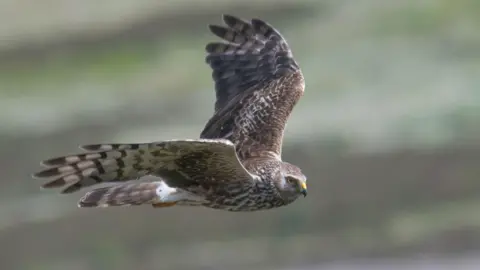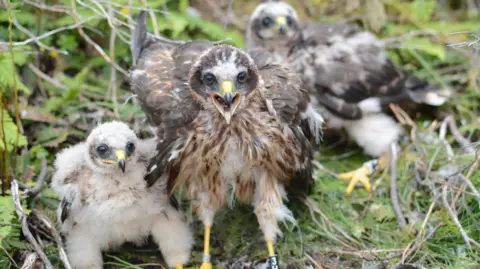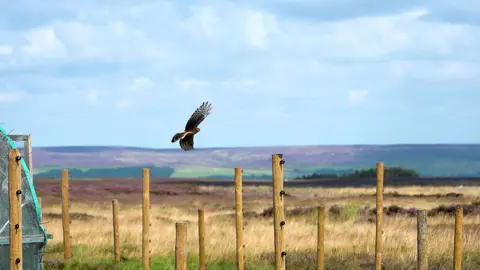Big increase in England's hen harrier numbers
 Tim Melling/National Trust/PA Wire
Tim Melling/National Trust/PA WireThere has been a large increase in hen harriers in England, up from four pairs in 2016 to 50 last year, a survey suggests.
According to the Hen Harrier Survey, populations of what is one of the UK's rarest birds of prey are now found in Northumberland, the North Pennines, Lancashire and the Yorkshire Dales.
The survey is carried out every seven years by the RSPB and other organisations.
The RSPB says the results give "cause for optimism", but "illegal killing" remains the species' biggest threat.
 RSPB Investigations Team
RSPB Investigations Team Known for their spectacular flight, hen harriers have traditionally been threatened by grouse moor management.
While their main prey are voles and meadow pipits, they also eat grouse chicks.
As recently as 2013 no Hen Harriers nested in England, but the survey shows there are now more than at any point since they were lost as a breeding species about 200 years ago.
However, the RSPB says its population in England is currently only 15 per cent of what the suitable available habitat can support.
There are no breeding pairs in upland areas such as the Peak District or the North York Moors.
 Natural England/PA Wire
Natural England/PA WireAs reported by Natural England in January, disappearances of hen harriers continue.
A total of 32 satellite-tagged birds vanished or were confirmed as being illegally killed in England in 2023.
Mike Shurmer, head of species for RSPB England, said: “England has seen a significant increase in breeding hen harriers since the last survey, but the starting point was shockingly low and we need to tackle its illegal persecution.
"They are still very thinly spread and we would like to see several hundred pairs across all the upland areas of England."
A spokesperson for the Moorland Association, which represents grouse moor managers, disputed the RSPB figures, adding: "There are many reasons why harriers perish and tags stop working.
"If any evidence of illegal activity is found, it should be reported to the police."
Follow BBC North East on X (formerly Twitter), Facebook and Instagram and BBC Cumbria on X (formerly Twitter), Facebook and Instagram. Send your story ideas to [email protected].
